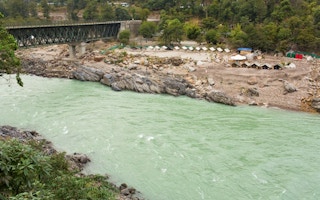Small hydropower (SHP) is considered safer than big dams in India’s quake-prone western Himalayas, but projects to build them get bogged down by administrative delays and other factors, says a new study.
Published last month (May) in Renewable Energy, the study proposes that the government fast-track SHP projects and proactively mitigate delays attributable to administrative, environmental, infrastructural, andtechnological causes.
Hundreds of big dams are being built or planned in the vast Himalayan region. The risks were highlighted by the severe damage caused to the 110-MW Rasuwagadhi Dam in Nepal by the 25 April quake. Fortunately, the dam which has a capacity of 1.5 cubic kilometre was empty.
In India’s Himalayan state of Himachal Pradesh, where the study was focused, most of the easily approachable sites had already been taken. The remaining sites were located in remote places that lacked infrastructure and transportation facilities, posing serious challenges to the development of SHPs.
“The Government can take initiatives such as building a web or satellite based system to monitor remote projects in real time. Such a system has great potential to reduce administrative delays”, says Deepak Kumar, lead author of the study and head of civil engineering at the Government Polytechnic, Hamirpur, Himachal Pradesh.
The study recommends improvement in road and telecom facilities to remote regions for better access and communication as well as silt-removing devices since Himalayan streams carry a lot of silt that damages hydro-electric equipment.
India’s SHP potential is pegged at about 20,000 megawatts with about 16,000 megawatts remaining untapped [1].
The researchers closely interacted with project affected people in Himachal Pradesh private businesses and government officials. They also examined hydro power policies in the state and official audits before recommending pro-SHP strategies.
Apart from being safer in seismic areas, small hydro power projects are cheap, easier to build and maintain, and can cater to villages in remote locations where grid connectivity is not feasible. There is evidence that several small dams are better than one big dam.
“A comparison of benefits of a big dam with a series of much smaller dams located in the tributaries of the same river show that the latter not only cost less but start giving benefits quicker and without impairing the environment,” says K. S. Valdiya, a geologist at the Jawaharlal Nehru Centre for Advanced Scientific Research, Bangalore, who has studied the Indian Himalayas extensively.
A recent report by the central government’s National Mission on Small Hydro addresses some of the challenges to SHPs and attempts to promote them.
Some experts continue to favour large-scale hydro-electric projects arguing that new technologies now available protect them from seismic events.
“By carefully locating various components of the project, using ductile materials in construction, adopting earthquake resistant designs and stabilising weak and potential shear zones, safe structures can be built,” says Gali Madhavi Latha, a geotechnical researcher at the Indian Institute of Science.
Link to abstract in ScienceDirect










